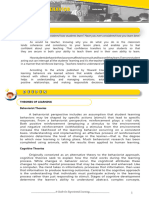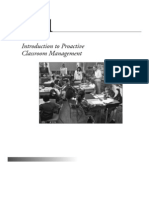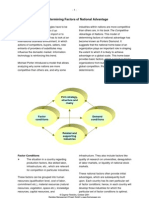0 ratings0% found this document useful (0 votes)
66 viewsProponents of Various Discipline Models: Theorists
Proponents of Various Discipline Models: Theorists
Uploaded by
Ronalyn InigoThe document summarizes different discipline models proposed by various theorists. It groups the models into low, medium, and high control approaches. For each approach, it lists the associated theorist and some of their core beliefs. It then provides a table comparing different classroom management theorists and their models, beliefs around behavior modification, group life, choice theory, assertive discipline, democratic teaching, congruent communication, instructional management, discipline with dignity, positive classroom management, and inner discipline.
Copyright:
© All Rights Reserved
Available Formats
Download as DOCX, PDF, TXT or read online from Scribd
Proponents of Various Discipline Models: Theorists
Proponents of Various Discipline Models: Theorists
Uploaded by
Ronalyn Inigo0 ratings0% found this document useful (0 votes)
66 views3 pagesThe document summarizes different discipline models proposed by various theorists. It groups the models into low, medium, and high control approaches. For each approach, it lists the associated theorist and some of their core beliefs. It then provides a table comparing different classroom management theorists and their models, beliefs around behavior modification, group life, choice theory, assertive discipline, democratic teaching, congruent communication, instructional management, discipline with dignity, positive classroom management, and inner discipline.
Original Title
Theorists
Copyright
© © All Rights Reserved
Available Formats
DOCX, PDF, TXT or read online from Scribd
Share this document
Did you find this document useful?
Is this content inappropriate?
The document summarizes different discipline models proposed by various theorists. It groups the models into low, medium, and high control approaches. For each approach, it lists the associated theorist and some of their core beliefs. It then provides a table comparing different classroom management theorists and their models, beliefs around behavior modification, group life, choice theory, assertive discipline, democratic teaching, congruent communication, instructional management, discipline with dignity, positive classroom management, and inner discipline.
Copyright:
© All Rights Reserved
Available Formats
Download as DOCX, PDF, TXT or read online from Scribd
Download as docx, pdf, or txt
0 ratings0% found this document useful (0 votes)
66 views3 pagesProponents of Various Discipline Models: Theorists
Proponents of Various Discipline Models: Theorists
Uploaded by
Ronalyn InigoThe document summarizes different discipline models proposed by various theorists. It groups the models into low, medium, and high control approaches. For each approach, it lists the associated theorist and some of their core beliefs. It then provides a table comparing different classroom management theorists and their models, beliefs around behavior modification, group life, choice theory, assertive discipline, democratic teaching, congruent communication, instructional management, discipline with dignity, positive classroom management, and inner discipline.
Copyright:
© All Rights Reserved
Available Formats
Download as DOCX, PDF, TXT or read online from Scribd
Download as docx, pdf, or txt
You are on page 1of 3
Theorists
Proponents of Various Discipline Models
The Guiding Model The Interacting Model The Intervening Model
Low Control Approaches Medium Control Approaches High Control Approaches
Congruent Communication Logical Consequences Behavior Modification
Haim Ginott Rudolf Dreikurs B.F. Skinner
Use sane messages Teach in a democratic Identify desired behaviors
manner
Invite student Identify and confront Shape behavior through
cooperation students’ mistaken goals reinforcement
Express helpfulness and Use logical consequences Use behavior modification
acceptance systematically
Discipline as Self-Control Cooperative Discipline Assertive Discipline
Thomas Gordon Linda Albert Lee and Marlene Canter
Identify problem Establish a sense of Recognize classroom
ownership belonging rights
Maximize communication Build student self-esteem Teach desired behavior
Use the power of influence Promote cooperative Establish consequences
relationships
Teaching with Love and Positive Classroom Discipline Positive Discipline
Logic
Jim Fay and David Funk Jane Nelsen, Lynn Lott, and H. Fredric Jones
Stephen Glenn
Share control with students Use classroom meetings Structure classrooms
Maintain student self- Exhibit caring attitudes and Set limits and promote
concepts behaviors cooperation
Balance consequences with Use management skills Have back-up systems
empathy
Inner Discipline Noncoercive Discipline Discipline Without Stress
Barbara Coloroso Williams Glasser Marvin Marshall
Enable students to solve Provide quality education Promote responsibility
problems rather than obedience
Provide support and Helps students make good Guide and monitor
structure decisions behavior
Treat students with Provide support and Teach the social
dignity and respect encouragement development and
management system
From Discipline to Discipline with Dignity
Community
Alfie Kohn Richard Curwin, Allen Mendler,
and Brian Mendler
Provide an engaging Create a three-dimensional
curriculum plan
Develop a caring Establish a social contract
community
Allow students to make Teach students to make
choices responsible choices
Classroom Management Theorist and Models
Theorist Model Basic Beliefs
B. F. Skinner Behavior Modification Educators use positive and negative
reinforcements or rewards and
punishments to modify or shape
students’ behavior.
Fritz Redl and William Group Life and Educators encourage students to
Wattenberg Classroom Discipline understand their behavior and actions.
Understanding that student behavior
differs individually and as a member of a
group, educators support students’
unpleasant situations to modify
behavior.
William Glaser Choice Therapy and Schools help satisfy students’
Quality Schools psychological needs and add quality to
their life. Educators teach, manage,
provide caring environments, and
conduct class meetings in a way that
adds quality to students’ lives.
Thomas Gordon Teacher Effectiveness Educators teach self-discipline,
demonstrate active listening, send “I-
messages,” and teach a six-step conflict
resolution program.
Lee Canter and Marlene Assertive Discipline Educators and students have rights in the
Canter classroom. Educators insist upon
responsible behavior and use a
hierarchical list of consequences to
manage behavior.
Rudolph Dreikurs Democratic Teaching Misbehavior results from four major
causes (or mistaken goals). Educators
use democratic teaching, logical
consequences, and encouragement rather
than praise.
Haim Ginott Congruent Educators demonstrate their best
Communication behaviors (harmonious with students’
Theorist Model Basic Beliefs
feelings about themselves and their
situations) and promote self-discipline as
an alternative to punishment.
Jacob Kounin Instructional Educators use effective instructional
Management behaviors (teaching techniques,
movement management, and group
focus) to influence student behaviors.
Richard Curwin and Allen Discipline with Dignity Educators protect the dignity of
Mendler students. Teachers are fair and consider
individual situations (as opposed to rigid
rules), list rules that make sense to
students, and model appropriate
behaviors.
Frederic Jones Positive Classroom Positive classroom management
Management procedures affirm students. Educators
set limits; build cooperation; and use
practical, simple, and easy-to-use
strategies.
Barbara Coloroso Inner Discipline Students are worth the time and effort it
takes to teach them responsible
behavior. Educators avoid punishment
and evaluative praise. Instead, they
model conflict resolution and use natural
consequences.
You might also like
- Social Media Marketing ProposalDocument5 pagesSocial Media Marketing ProposalGabe Jnr100% (2)
- Schools Division of Tarlac ProvinceDocument4 pagesSchools Division of Tarlac ProvinceDonny BuenoNo ratings yet
- Restorative Practices GuideDocument16 pagesRestorative Practices Guideapi-298156273No ratings yet
- The Trauma of Freud Controversies in Psychoanalysis PDFDocument318 pagesThe Trauma of Freud Controversies in Psychoanalysis PDFMinuxNo ratings yet
- Biopsychosocial ModelDocument13 pagesBiopsychosocial ModelAzlan AzizanNo ratings yet
- ManagementDocument30 pagesManagementSaptarshi Mukherjee100% (1)
- Practical Approaches To Manage Challenging Behaviour.: Commented (SC1)Document9 pagesPractical Approaches To Manage Challenging Behaviour.: Commented (SC1)api-457784453No ratings yet
- Guided Discipline PDFDocument18 pagesGuided Discipline PDFManuelNo ratings yet
- Classroom Discipline Strategies for a Positive Learning EnvironmentDocument9 pagesClassroom Discipline Strategies for a Positive Learning Environmentbitancorsheena1No ratings yet
- Canter Assertive Discipline ModelDocument24 pagesCanter Assertive Discipline ModelFarah Sofea RazaliNo ratings yet
- Comparison Between Thomas Gordon Classroom Management Model, Dreikurs Logical Consequences Model and Canter Assertive Discipline ModelDocument1 pageComparison Between Thomas Gordon Classroom Management Model, Dreikurs Logical Consequences Model and Canter Assertive Discipline ModeltizalikaNo ratings yet
- Ted626 Managementnotebook DomainfartifactDocument46 pagesTed626 Managementnotebook Domainfartifactapi-463420931No ratings yet
- Topic 2: 2.1 Classroom Management Approaches 2.2 Theories and Models of Classroom ManagementDocument35 pagesTopic 2: 2.1 Classroom Management Approaches 2.2 Theories and Models of Classroom ManagementAbdelghni IdrissiNo ratings yet
- Cstp2 Mark BricenoDocument11 pagesCstp2 Mark BricenoMark BricenoNo ratings yet
- CSTP 2 Garcia 4Document11 pagesCSTP 2 Garcia 4api-328938961No ratings yet
- Unit 5 8605Document25 pagesUnit 5 8605Saiqa Ashrif AshrifNo ratings yet
- Discipline As Self ControlDocument2 pagesDiscipline As Self ControlIzat UmayrahNo ratings yet
- CSTP 2 Knepper 043024Document13 pagesCSTP 2 Knepper 043024api-635789824No ratings yet
- 2 CSTPDocument9 pages2 CSTPapi-432388156No ratings yet
- Class Room Management - Behaviour ManagementDocument27 pagesClass Room Management - Behaviour Managementsadaf hashmi0% (1)
- Experiential Learning 1Document7 pagesExperiential Learning 1MARISOL SALESNo ratings yet
- 3 Approach in Classroom ManagementDocument14 pages3 Approach in Classroom ManagementDwi WedayanthiNo ratings yet
- Edu 201 Lesson Planning Assessment Audrey WoodDocument29 pagesEdu 201 Lesson Planning Assessment Audrey Woodapi-610748030No ratings yet
- Artifact 2 Chapter Presentation 1Document20 pagesArtifact 2 Chapter Presentation 1api-583585486No ratings yet
- Prelim Ri Group 2Document23 pagesPrelim Ri Group 2Mary Angeline De LeonNo ratings yet
- Ij 3Document3 pagesIj 3api-401933204No ratings yet
- Group 10Document27 pagesGroup 10সাঈদ মুহাম্মাদ সানোয়ারNo ratings yet
- Promoting Well Being Building Resilient School CommunitiesDocument8 pagesPromoting Well Being Building Resilient School CommunitiesZamira AkramovaNo ratings yet
- ACU Masters of Secondary Teaching - Classroom Management 1Document9 pagesACU Masters of Secondary Teaching - Classroom Management 1kattaylor651No ratings yet
- T8 Students DisciplineDocument27 pagesT8 Students DisciplineDhiahVersatil100% (1)
- Models Associated With Subject Matter/Discipline: Prepared By: Catherine A. Matias BSED-III Social ScienceDocument27 pagesModels Associated With Subject Matter/Discipline: Prepared By: Catherine A. Matias BSED-III Social ScienceFrancis Hassel Pedido100% (1)
- Affective Learning CompetenciesDocument5 pagesAffective Learning CompetenciesRejan May ButalidNo ratings yet
- Lesson 1&2Document9 pagesLesson 1&2Pitche RUSILNo ratings yet
- Classroom Management Plan Ed PlanningDocument11 pagesClassroom Management Plan Ed Planningapi-253536172No ratings yet
- Gmrc Report (Group7)Document27 pagesGmrc Report (Group7)janev7418No ratings yet
- Yeni Microsoft Word BelgesiDocument2 pagesYeni Microsoft Word Belgesiapi-735172868No ratings yet
- 2 Classroom Management TheoriesDocument30 pages2 Classroom Management TheoriesDwi WedayanthiNo ratings yet
- Classroom Management For Effective TeachingDocument4 pagesClassroom Management For Effective Teachingfendi.sebastian.2302218No ratings yet
- Classroom Management For Effective Teaching: December 2015Document4 pagesClassroom Management For Effective Teaching: December 2015Anonymous Cstf7SoNo ratings yet
- Cjohnston Managementbrochure 22febDocument2 pagesCjohnston Managementbrochure 22febapi-378586143No ratings yet
- cstp2 2009 5 1 24Document17 pagescstp2 2009 5 1 24api-637118082No ratings yet
- CSTP 2 Fleischner 423Document18 pagesCSTP 2 Fleischner 423api-570352555No ratings yet
- Pple - Presentation Ple 1Document22 pagesPple - Presentation Ple 1api-408516407No ratings yet
- Classroom Management Strategies & Practices: Mara Zapata, Ph.D. EDG 3443 - Classroom & Behavior ManagementDocument9 pagesClassroom Management Strategies & Practices: Mara Zapata, Ph.D. EDG 3443 - Classroom & Behavior ManagementVeronica Alvarez-GallosoNo ratings yet
- Collaborative Activity: Classroom Management TheoriesDocument28 pagesCollaborative Activity: Classroom Management TheoriesRochelle Esteban100% (1)
- cstp2 Volen 5Document13 pagescstp2 Volen 5api-573200924No ratings yet
- Collaborative Activity: Classroom Management TheoriesDocument28 pagesCollaborative Activity: Classroom Management TheoriesDaniel DubeNo ratings yet
- Learning Task No.5Document3 pagesLearning Task No.5Rosemarie Cabuco RazNo ratings yet
- Classroom Management - KeyDocument31 pagesClassroom Management - KeyLuhan NismNo ratings yet
- Classroom Management Supportive Startegies PDFDocument4 pagesClassroom Management Supportive Startegies PDFArturo GallardoNo ratings yet
- CSTP 2 Cipres 4Document12 pagesCSTP 2 Cipres 4api-635911043No ratings yet
- Dreikurs Kounin Ginott Models CLASSROOM MANAGEMENTDocument39 pagesDreikurs Kounin Ginott Models CLASSROOM MANAGEMENTGrace JeffreyNo ratings yet
- Ted626management Notebook PTDocument10 pagesTed626management Notebook PTapi-448704934No ratings yet
- Henley Ch1 Introduction To Proactive Classroom ManagementDocument22 pagesHenley Ch1 Introduction To Proactive Classroom ManagementRachel McWatters100% (1)
- CSTP 2 Camp Updated 5:6:23Document15 pagesCSTP 2 Camp Updated 5:6:23Nancy CampNo ratings yet
- Lacsi - Trait TheoryDocument5 pagesLacsi - Trait TheoryChanissa Rhee Gicole LacsiNo ratings yet
- Introduction To Value-Based EducationDocument8 pagesIntroduction To Value-Based Educationadikulkarni71No ratings yet
- Classroom Management NotesDocument1 pageClassroom Management NotesTESL30621 Siti Khadijah Binti ShaharudeanNo ratings yet
- Structuring Learning Environments in Teacher Education to Elicit Dispositions as Habits of Mind: Strategies and Approaches Used and Lessons LearnedFrom EverandStructuring Learning Environments in Teacher Education to Elicit Dispositions as Habits of Mind: Strategies and Approaches Used and Lessons LearnedNo ratings yet
- Investigating the Emotional and Physical Aspects of the Language ClassroomFrom EverandInvestigating the Emotional and Physical Aspects of the Language ClassroomNo ratings yet
- Reflective Practice of Multi-Unicultural School LeadersFrom EverandReflective Practice of Multi-Unicultural School LeadersNo ratings yet
- Natural Secince Vs Social SciencesDocument31 pagesNatural Secince Vs Social SciencesKavinda DeshanNo ratings yet
- Salesperson Performance Evaluation A Sys1Document19 pagesSalesperson Performance Evaluation A Sys1Shahadat HossainNo ratings yet
- Porter's Diamond - Determining Factors of NationalDocument3 pagesPorter's Diamond - Determining Factors of NationalsaudbogutNo ratings yet
- Unfaithfulness Among Married Couples: John MapfumoDocument13 pagesUnfaithfulness Among Married Couples: John MapfumoAishinite CMNo ratings yet
- FS2-Episode 3Document4 pagesFS2-Episode 3Angela MagallanesNo ratings yet
- Detailed Lesson Plan - Claim & Types of ClaimsDocument8 pagesDetailed Lesson Plan - Claim & Types of ClaimsDanica SantosNo ratings yet
- Topic 1 Scientific SkillsDocument10 pagesTopic 1 Scientific SkillsMohd Khuzaimi Mie100% (2)
- Unveiling Your Past Life Destiny: How Past Lives Influence Your Present and FutureDocument3 pagesUnveiling Your Past Life Destiny: How Past Lives Influence Your Present and FutureAashutoshNo ratings yet
- Guimbuayan, Fritzie Mae Ruzhel DDocument5 pagesGuimbuayan, Fritzie Mae Ruzhel DFritzie Mae Ruzhel GuimbuayanNo ratings yet
- Tell Me About Yourself.: TRAPS: Beware, About 80% of All Interviews Begin With This "Innocent" Question. ManyDocument1 pageTell Me About Yourself.: TRAPS: Beware, About 80% of All Interviews Begin With This "Innocent" Question. ManyAbhishekNo ratings yet
- Theory and History of OntologyDocument8 pagesTheory and History of Ontologyakms_Saif2521No ratings yet
- Integrity and Accountability - 17 May 2019Document58 pagesIntegrity and Accountability - 17 May 2019Richu NNo ratings yet
- Lacan - Mirror Stage - Sheridan PDFDocument5 pagesLacan - Mirror Stage - Sheridan PDFsantanu6No ratings yet
- Baby Yoga PresentatonDocument11 pagesBaby Yoga PresentatonAlyssa ProskeNo ratings yet
- BMET ENTERPRISE AcademyDocument2 pagesBMET ENTERPRISE AcademyDarren FianderNo ratings yet
- A-332 Anyayahan JohnPatrick E-PortfolioDocument3 pagesA-332 Anyayahan JohnPatrick E-PortfolioJohn Patrick AnyayahanNo ratings yet
- Power Distance Index in Work CultureDocument1 pagePower Distance Index in Work CultureHumanologyNo ratings yet
- CritiqueDocument2 pagesCritiqueRamareziel Parreñas RamaNo ratings yet
- 22 Highly-Effective Bar Exam Tips PDFDocument7 pages22 Highly-Effective Bar Exam Tips PDFMark Christian B. ApordoNo ratings yet
- Theoritical and Conceptual FrameworkDocument66 pagesTheoritical and Conceptual FrameworkRyan oliver TorresNo ratings yet
- Diu Lei Lou Mou Chau HaiDocument1 pageDiu Lei Lou Mou Chau HaiChoong Cheng LounNo ratings yet
- The Ambiguity of Anne Sexton's Poems Especially 'Us'Document6 pagesThe Ambiguity of Anne Sexton's Poems Especially 'Us'Siti AisahNo ratings yet
- Fls BPPDocument3 pagesFls BPPMelanie LamperaNo ratings yet
- Do We Understand The Prefrontal Cortex?: Richard E. Passingham Hakwan LauDocument11 pagesDo We Understand The Prefrontal Cortex?: Richard E. Passingham Hakwan LauTuấn Anh PhạmNo ratings yet
- CodependencyDocument2 pagesCodependencyMartha3672No ratings yet
- Final Project - Autoethnography Andrea GarciaDocument7 pagesFinal Project - Autoethnography Andrea Garciaapi-711173469No ratings yet

























































































